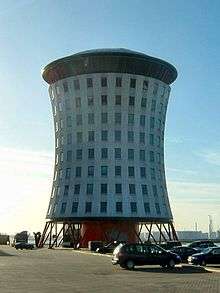Mammoet
 | |
| Private | |
| Industry | Logistics, Heavy Lifting Services, Heavy Transport Services, Plant Turnaround, Shutdown Management |
| Headquarters | Schiedam, Netherlands |
Key people | Paul van Gelder (CEO) |
| Owner | SHV Holdings |
Number of employees | 5,000 (2018) |
| Website |
www |
Mammoet is a privately held Dutch company specialized in engineered heavy lifting and transport of oversized and heavy objects.
History

Mammoet’s history started on 13 May 1807 in The Netherlands, when the Dutch entrepreneur Jan Goedkoop founded a maritime company at the age of 25, with the purchase of a 140-ton cargo vessel. It was the beginning of the industrial revolution and Goedkoop foresaw that heavy transport would be in high demand. The company, called 'Gebroeders Goedkoop' (‘Goedkoop Brothers’), offered both cargo and passenger transport on water. In 1862 the company acquired its first tugboat, and from 1920 onwards, the company focused on tug- and salvage services.
In 1971 Goedkoop merged with Van Wezel from Hengelo, a company specialized in heavy transport and cranes. The new company was called Mammoet Transport. In 1972 another company was acquired, Stoof Breda, which at that time was one of the Dutch market leaders in engineered heavy lifting and transport.
In 1973 Mammoet Transport became a subsidiary of Koninklijke Nederlandse Stoomboot-Maatschappij (KNSM) in Amsterdam. At the same time the company name was changed to Mammoet. In 1973 Mammoet Shipping was founded. This enabled Mammoet to reinforce its "factory-to-foundation" concept, which allowed the company to transport large objects, such as vessels and modules, from the factory to their destination site – anywhere in the world – and install them.
In 1981 KNSM and Mammoet became part of Nedlloyd Group. In 2000 Mammoet was acquired by and merged with Van Seumeren Kraanbedrijf, a company that had been founded in 1966. In 2001 Mammoet sold its maritime branch Mammoet Shipping to shipping company Spliethoff.
One year after the merger, Mammoet writes world history with the successful salvaging operation of the Russian submarine Kursk in the Barents sea. In the years after the company becomes the global market leader in engineered heavy lifting and transport. Mammoet offers the following services:
1. Rental of heavy lifting and transport equipment and personnel; 2. Heavy lifting and transport services for the maintenance of plants and installations; 3. Heavy lifting and transport services for special projects, such as the construction of factories, installations and building, as well as large infrastructure projects.
The company is active in the petrochemical industry, the energy sector, off-shore and civil construction. Globally, approximately 5,000 people work for the company, in about 90 offices and branches. The head office of the holding company is located in Utrecht. The European headquarters, located in Schiedam, are quite special because it was constructed on a separate yard and sailed on a barge to its destination site, where it was driven to its final location with SPMTs. Mammoet has offices in North America, South America, the Middle East, Africa and Asia.
Executive Board of Management
Currently, the following persons are active on Mammoet's Executive Board of Management
- Paul van Gelder (1969), Chief Executive Officer
- Jan Kleijn (1968), Chief Operational Officer
- Kees Voormolen (1962), Chief Financial Officer
- Martijn Roelants (1970), Chief People Officer
Use of 'Mammoet' and logo by other companies
Two (former) daughters of Mammoet use a similar logo:
- Mammoet Road Cargo, heavy and special road transport
- Mammoet Ferry Transport, transport company between UK and continental Europe
Mammoet Ferry Transport was a unit of Mammoet until 2000. After a management buy-out it became an independent company. Mammoet Road Cargo also used to be part of the Mammoet holding, but is now only 10% owned by Mammoet.
See also
External links
| Wikimedia Commons has media related to Mammoet. |